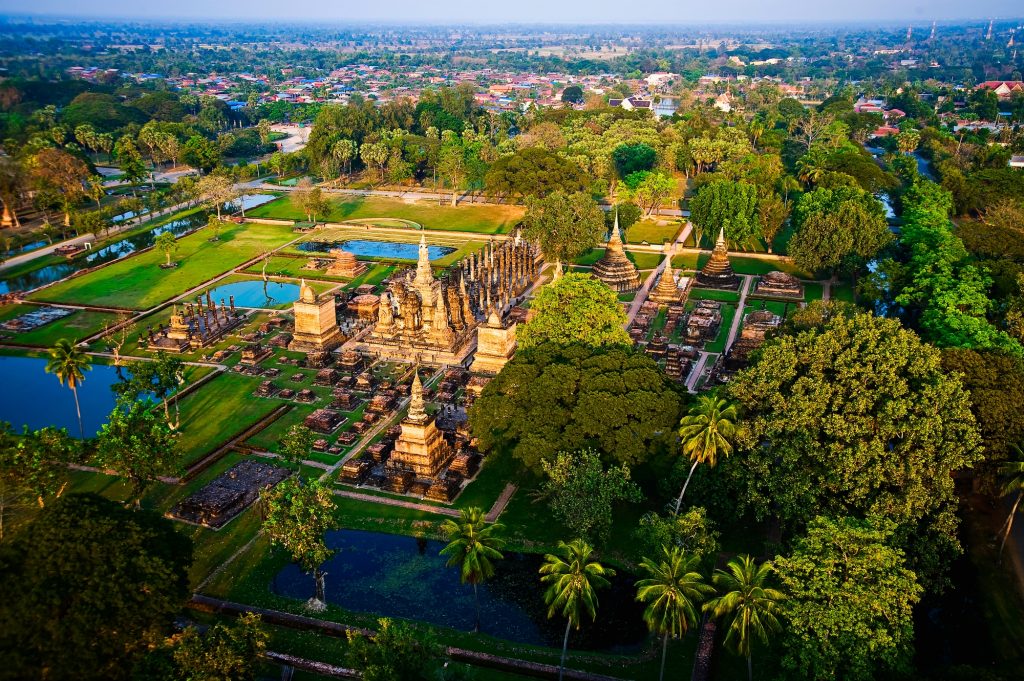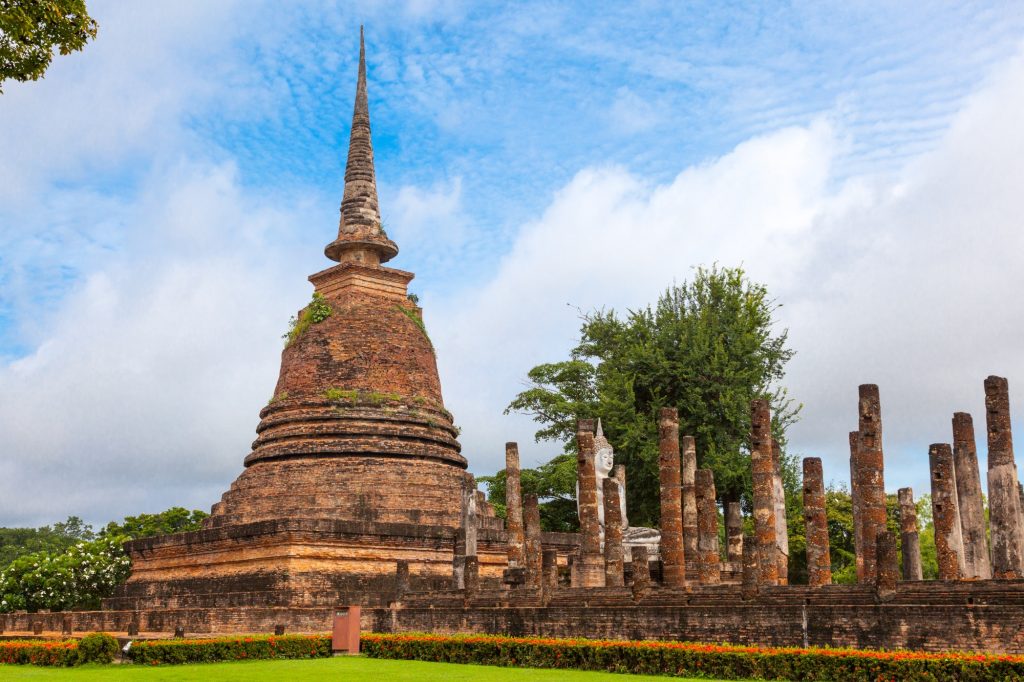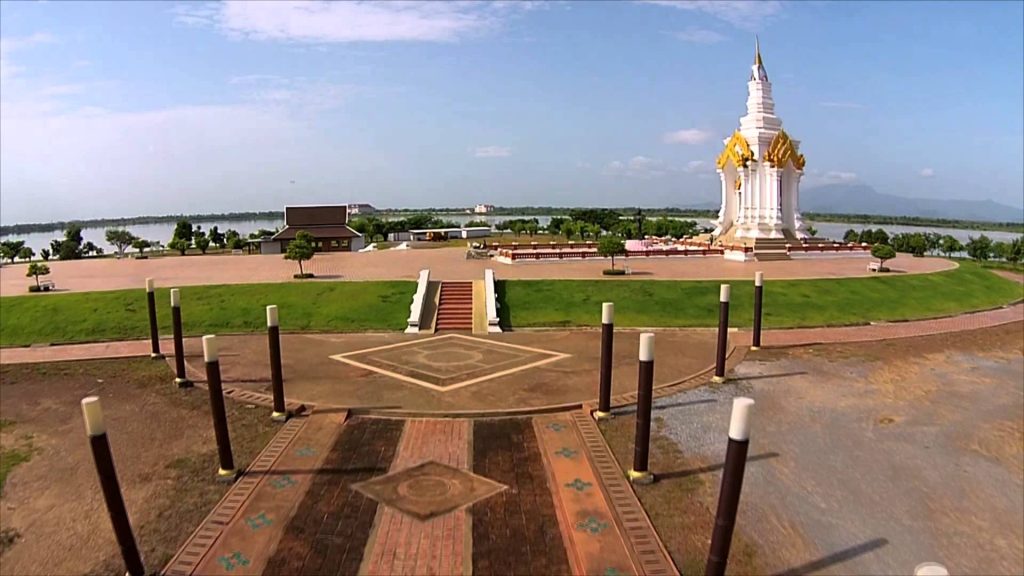In the 13th and 14th centuries, the first Kingdom of Siam had the Historic Town of Sukhothai as its political and administrative capital. Situated in the lower northern region of present-day Thailand, this town boasts one of Thailand’s most impressive UNESCO World Heritage Sites, including a number of fine monuments which represent the beginnings of Thai architecture.
If you’re a student of ancient Thai history and culture, you’ll love Sukhothai. The following are some of the best Sukhothai historical landmarks and temples we recommend you visit.
Historical Landmarks & Temples in Sukhothai
Sukhothai Historical Park

Extensive, fascinating, peaceful, well-maintained and spotlessly clean, Sukhothai Historical Park is easily one of the most popular landmarks in the town, and the best of Thailand’s 11 historical parks.
It is comprised of the restored ruins or remains of royal palaces, Buddhist temples, wonderful historical statues of Buddha, the city gates, walls, moats, several large reservoirs or ponds, the water dike control system of ancient Sukhothai, an amazing flora and fauna, and more.
To get around faster in this large park, it’s best to rent a mini truck or bicycle at the guest house in front of the park.
Wat Sri Sawai

Originally built in the late 12th and early 13th centuries as a Hindu temple, Wat Sri Sawai is one of the oldest in Sukhothai.
Though this small temple within the Historical Park is ancient, it is well-preserved and good-looking, featuring three Khmer Prangs that dominate the site. One of the objects of interest in the vicinity of Wat Sri Sawai is an old ficus tree with impressive gnarled roots; this is just outside the temple walls to the right.
Si Satchanalai Historical Park

The Si Satchanalai Historical Park is situated on the banks of the Yom River, and made up of the ruins of an ancient town that was formerly called “Muang Chaliang”.
The forest-like park is somewhat far from the town; it is also large, well-kept and quiet, just like the Sukhothai Historical Park. There are over 134 monuments from the past, and the ruins, though unrestored, are a sight to behold. Note that the ruins outside of the main square way off to the side are a distance away, so are best visited using a vehicle.
Wat Sa Si

Another stunning ancient site that is a must-visit is the Wat Sa Si. One of the smaller temples in Sukhothai, it is well-preserved, and nicely situated in the middle of a small lake, with a bridge going over the water to the temple.
Because it overlooks the water which somehow helps to highlight its beauty, Wat Sa Si looks quite appealing, and photo enthusiasts will have a field day capturing the attractions which include a stupa.
King Ram Khamhaeng Monument

The King Ram Khamhaeng Monument is a solemn site where many of the locals come to pray and offer respect. It is prominently located within the main section of the Sukhothai Historical Park.
King of Sukhothai in the latter part of the 13th century, Ram Khamhaeng himself remains an important figure in Thai history, a revered monarch who introduced the Thai alphabet and opened up trade with neighboring countries.
While his monument may not mean much to you as a foreigner, it is well worth a visit.
Wat Mahathat

Sukhothai’s largest temple, Wat Mahathat, is located in the center of the moated section of the old city, right behind the Royal Palace.
Chief among the highlights of this temple is a seated, magnificent, bronze Buddha image cast in the Sukhothai style by King Lithai of Sukhothai in 1362, and the two 9-meter-tall, standing Buddha statues on each side of the temple.
Wat Mahathat is the place where Buddha’s relics are said to have been enshrined, and the ruins are overall a sight to behold.
Thung Talay Luang

Also known as “The Holy Heart Land”, Thung Talay Luang is a man-made island shaped in the form of a heart, with a temple right in the center.
Situated near the Thalay Luang Stadium, this site is surrounded by a shallow lake – about 2 meters deep – on which fishing is allowed. Visitors usually bring refreshments on their way here so they can sit under the trees at the waterside and enjoy the views and peaceful atmosphere.
Wat Saphan Hin

Wat Saphan Hin, or the Temple of the Stone Bridge, is a remote structure a few kilometers west of the old city, close to the Historical Park.
Standing atop a hill that is more than 200 meters high, the temple is accessible via a steep rocky pathway which inspired its name, and which can be slippery when wet. A 15-minute hike will get you to the summit of the hill where there’s a 12.5-meter-tall, stucco standing Buddha, watching over the city below, with hand raised in an attitude of forgiveness.
The view from the hill is fascinating, and this is the best spot to enjoy the sunrise.
Phra Mae Ya Shrine

Highly respected by the residents of Sukhothai, the Phra Mae Ya Shrine is situated in front of the City Hall, and is home to a 1-meter-high idol of Phra Mae Ya – a stone figure dressed as an ancient queen, and sporting a long face, a tapered chin, plus a long halo.
The shrine was built during King Ram Khamhaeng the Great’s reign as a dedication to his late mother, Nang Sueang, and is believed to house his spirit today. The complex has two different temples: One for the Buddha and one for the king’s mother or city goddess.
Wat Chang Lom

Wat Chang Lom, meaning “temple surrounded by elephants”, is located in the central zone of the quiet, peaceful Si Satchanalai Historical Park, and was built in the 14th century.
The temple got its name from its main, Sinhalese style, bell-shaped stupa with a base surrounded by 39 large elephant sculptures – eight on the east side, nine on the other sides and one larger elephant at each of the four corners. Most of these sculptures are in a state of disrepair, though they were once covered with plaster adorned with elaborate carved decorations.
Remember that what you’ve just read are only some of the top historical landmarks and temples in Sukhothai, and the ancient town has several more that are also impressive or interesting.





